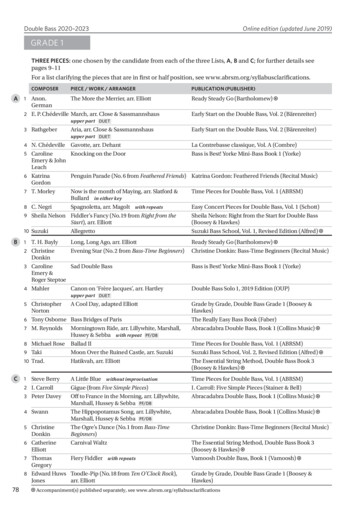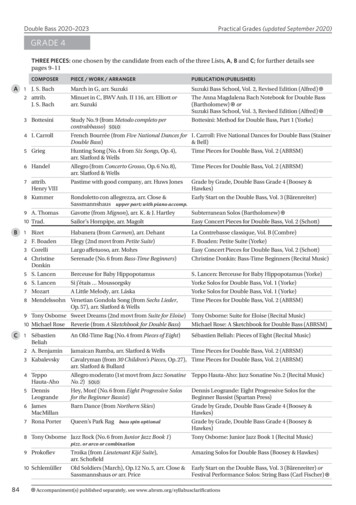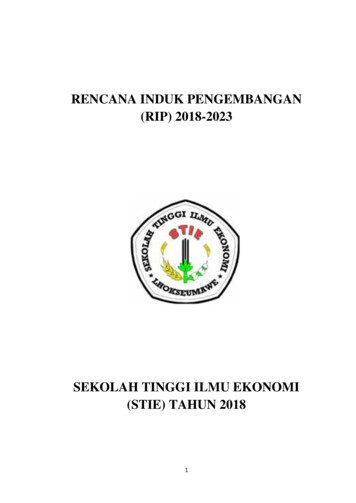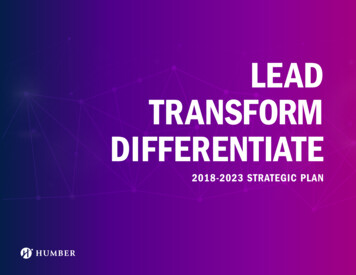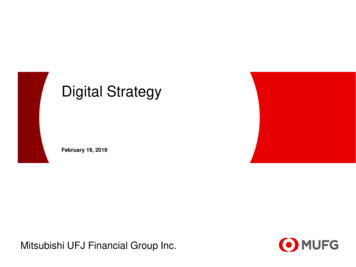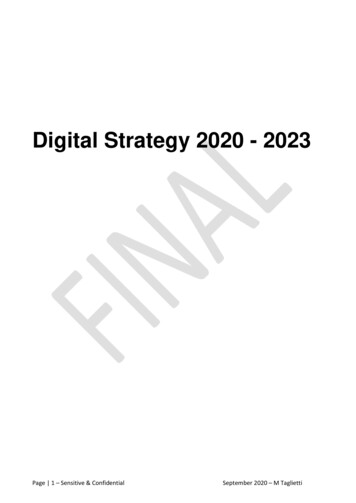
Transcription
Digital Strategy 2020 - 2023Page 1 – Sensitive & ConfidentialSeptember 2020 – M Taglietti
ContentsContentsIntroduction . 3Strategic Review & Solutions . 42018 Digital Strategy Review – GAP Analysis . 4Cyber Security. 4Application Review & Strategy . 5Service Model . 6Service Offer . 7Solutions . 7The Plan (Stabilise, Optimise & Transform) . 7Conclusion . 8Page 2 – Sensitive & ConfidentialSeptember 2020 – M Taglietti
IntroductionThis document sets out a refreshed Ulster University Digital Strategic vision and plan for 2020 to 2023. It details howInformation Services will provide technical, digital, information and application strategies to underpin the operational runningof the University, whilst enabling transformation and growth.It recognises the fundamental change brought about by COVID and the need to develop solutions to support greater mobilityin a secure, sustainable, and agile manner. Including the greater use of cloud and managed services, remote solutions andstandardised platforms, and the centralisation of procurement and support services.All of which requires a new operating model and solution set, with a cultural shift that focuses on partnerships, collaboration,and shared outcomes across all corners of the University.It builds upon principles and ambitions outlined within the 2018 Digital Strategy based upon ‘empowering people throughdigital”, and provides staff and students access to enabling technologies and digital services across a range of foundationinfrastructure and end user platforms, both in a localised, cloud, and mobile manner.The ambition is the delivery of robust, scalable, resilient and performant applications and infrastructure that are seamless toour users. With technology services enabling access to information at the right time, in the right setting, on the right device,in context, and in a secure way.This vision will be enabled by building upon existing strategies, structures, technologies, processes, and relationships, whilstimplementing best practice ways of working and taking advantage of new and emerging solutions. Some will requireinvestment, though we will redirect existing funding where possible.Through the lens of a staff member a newly formed Digital Services will be highly visible, engaged, supportive, responsive,and always professional in our approach. Service reporting will be improved, and our work will be based upon the use ofbest practice in areas of service management, process, governance, and policy. We will operate as a trusted partner to thewider university and a strategic enabler.For the student, the digital journey needs to be seamless with greater emphasis and focus placed upon their Digital wants,needs, and requirements. This is our intent.Points discussed within this Digital Strategy are: Need to stabilise, optimise and transform existing service offer.Deliver against recommendations identified through the 2018 Digital Strategy.Provide best in class foundation technology and digital services capability.Adopt ‘best practice’ standards, frameworks, and processes to assure service quality.Service & Application review.Improved governance across cyber, delivery and reporting.Place our staff and students at the core of everything we do, and delight in service delivery.Become a trusted and fully engaged partner across all functions of the University estate, and the studentpopulation.Key to which will be re-branding of the Information Services Division (ISD) to Digital Services, building a new model ofworking, and re-defining the service offer.In delivery we work in a spirit of partnership and collaboration, and develop a more formalised approach to service delivery,which in the early stages may be disruptive. We will develop and propose a centralised approach to standardisation andprocurement of technology assets, and a review of the funding model needed to enable this Digital Strategy.This Digital Strategy is based upon a three-point plan. Stabilisation, i.e., ‘fixing what is broken’.Optimisation, ‘leverage what is already in place’.Transformation’ design, develop and build a new service delivery model and long-term application and informationstrategy.To enable transformation and growth we must develop and adapt accordingly, and although this strategy makes not ask forincreased funding it may be required as we develop our delivery plans.Page 3 – Sensitive & ConfidentialSeptember 2020 – M Taglietti
Strategic Review & SolutionsReview existing technology and application solution sets, including service offer, the organisational structure, infrastructure,digital, technical, information and application estate, and cyber security controls and plans.Some technology sets in use are current but others are aged need upgrading or replacing, this is known as the ‘technicaldebt’ and will also be reviewed.Historically solutions been procured in a decentralised manner whereby standardisation was difficult to achieve, and in theseenvironments ISD have little, or no, oversight or control. This poses a security threat and must be addressed.Elements of Cyber Security technical controls are in place but not centrally managed or delivered in a unified way. Thisposes a significant risk and could, if left unattended, result in system loss, data loss, financial loss and reputational damageto the University. This must be addressed.In doing so Digital Services will positively engage stakeholders to Review, rationalise and develop enabling infrastructure, commodity technology platforms and applications requiredto support digital transformation and enable new ways of working.Develop and promote solutions to consolidate and standardise solutions sets.Listen to our customers and develop services to promote the delivery of information at the right time, in the rightsetting and on the right device.Build trust and confidence in the work that we do, and service we provide. Digital Services will become a trustedadvisor and strategic partner to all functions of the University.Develop a robust approach to Cyber Security preparedness and incident response.We will do this in a way that reflects our values and behaviors and ensures Digital Services, staff, and students have accessto highly available infrastructure, information, digital, applications and technology services.This will be enabled through: Leveraging existing investment in infrastructure and technology platforms.Implementation of modern teaching and learning solutions and technology infrastructure.Implementation of commercially focused sourcing strategies.Development of digital partnerships and working with suppliers to design and deploy solutions that are scalableacross the Higher Education economy.StandardisationInvestment in Cyber SecurityIn doing so Digital Services will Review all existing services and develop and well-constructed and clear service catalogue, including details onservice criticality, service response and those services which required 24x7 service and support.Review all Enterprise applications and work to develop a future applications roadmap.2018 Digital Strategy Review – GAP AnalysisThe roadmap included within the 2018 Digital Strategy outlined a series of ambitions, deliverables, and outcomes acrosseach of the strategic themes. Although no timeline was placed upon delivery phasing was based upon a three-pointapproach, i.e., Now “Baseline”, Soon “Transitional” and “Future” StrategicIt is unclear if, when, or how, each item progressed, but Digital Services will review each deliverable and engage withstakeholders to ascertain their current and future state. This will be undertaken in conjunction with the applications reviewand outputs from which will inform the future application strategy and roadmap.Cyber SecurityA cross university approach to dealing with the Cyber threat is required. Investment for assessments, training, accreditation,tolling and dealing with the ‘technical debt’ is required.Cyber cannot be viewed as a like to have, but a must have, and it cannot be limited to the remit of the Digital Services.Page 4 – Sensitive & ConfidentialSeptember 2020 – M Taglietti
A University wide Cyber capability review is needed, with the outcomes used to develop remedial plans for priority areasand the development of business cases to mitigate risk. In this regard Digital Services will work towards attaining CyberEssentials and Cyber Essentials Plus accreditation. This is a Government backed, industry supported scheme to helporganisations protect against common online threats.This is an important first step as vulnerabilities to simple attacks could mark Ulster out as target for more in-depth attentionfrom cyber criminals. Cyber Essentials will provide peace of mind that our defenses will protect against most of commoncyber-attacks, simply because these attacks are looking for targets which do not have the Cyber Essentials technical controlsin place.Upon achieving Cyber Essentials, we will move towards the more rigorous certification level known as Cyber EssentialsPlus.As the Higher Education sector is becoming is direct target of Cyber Criminals, and high-profile attacks are occurring acrossthe sector, it is recommended that Ulster University that make both tactical and strategic plans to mitigate against Cyberthreats. This will require the use of dedicated, experienced subject matter experts, and external support. Discussions withsector partners validate the critically of this approach and support the need for the recruitment of a Chief Information SecurityOfficer (CISO), and Senior Security Technical Engineer. This should be considered.In progressing our Cyber plans Digital Service will follow the advice, guidance, and resources available through the NationalCyber Security Center (NCSC), The Joint Information Security Committee (JISC), and the Information Commissioner Office(ISO)A model proposed by the NCSC which is a core requirement of Cyber Essentials Plus is known as the “10 Steps to CyberSecurity’; which is outlined below. This is, and will continue to be, used to measure our Cyber maturity, and develop ourlonger-term Cyber plan.Application Review & StrategyDigital Services will review all applications and develop roadmap through consultation to identify those that could betolerated, eliminated, invested in, or migrated, for example to the Cloud or as part of a Managed Service. This approach willalso be used for Infrastructure and services.Assessment is based upon the Gartner PACE Layered application methodology that governs software applications throughtheir entire life cycle in support of evolving business requirements.A detailed application strategy and roadmap will be provided as the output from the application review.Detailed below is a high-level view of the existing tier-1 application estate which demonstrates that elements of the 2018Digital Strategy are progressing, with some applications already migrated into the Cloud and delivered as ‘Software as aServices”, otherwise known as SaaS.Outliers requiring further assessment include the Banner Student Record System, E5 Financials and Cognos BusinessIntelligence. These must be addressed.Skype for Business is becoming end-of-life and will be migrated across to Microsoft Teams, which is also delivered as aSaaS service.Page 5 – Sensitive & ConfidentialSeptember 2020 – M Taglietti
In relation to the Banner Student Record System Digital Services are renewing the existing license for a further 2 years, to2022. This period will be used to consider the long-term future need of this application, including potential renewal anddelivery as a Managed Service whereby hosting is provided in the cloud as part of a Software as a Service (SaaS) approach.Exploratory work for which has commenced.Service ModelThe approach to service modeling is represented below and based around the SIAM model (Service Integration &Management).SIAM is recognised as a ‘best practice’ approach to delivery of technology and digital services. In the case of Digital Servicesthis includes a mix of business and digital information technology solutions that integrate into a single business-facingorganisation.SIAM aims to seamlessly integrate services from various sources into a single end-to-end service offer, and in the contextof Ulster this includes three elements, namely customers (staff and students), the internal Digital Services function, andexternal parties such as suppliers and other sectoral partners, for example JISC.In practice this will ensure improvedportfolio management and delivery,enhanced customer experience andaccess to a dedicated relationshipmanagemen
This Digital Strategy is based upon a three-point plan. Stabilisation, i.e., ‘fixing what is broken’. Optimisation, ‘leverage what is already in place’. Transformation’ design, develop and build a new service delivery model and long-term application and information strategy. To enable transformation and growth we must develop and adapt accordingly, and although this .

